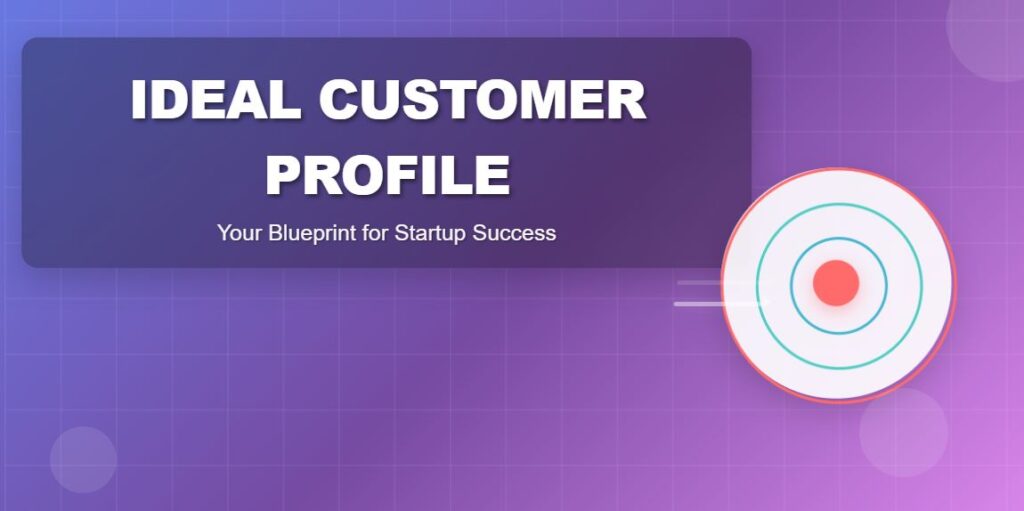Starting a business without knowing exactly who you’re serving is like shooting arrows in the dark. You might hit something, but you’re wasting resources and missing countless opportunities. This is where your Ideal Customer Profile (ICP) becomes your guiding star.
What is an Ideal Customer Profile (ICP)?
An Ideal Customer Profile is a detailed description of the type of customer who would get the most value from your product or service. It’s not just demographics like age and location – it’s a comprehensive picture that includes pain points, buying behaviors, company characteristics (for B2B), and the specific circumstances that make someone likely to purchase and succeed with your solution.
Think of your ICP as the bullseye on your target market dartboard. While your total addressable market might be everyone who could theoretically use your product, your ICP represents those who are most likely to buy, stay loyal, and become advocates for your brand.
Key Components of a Strong ICP
For B2C Businesses:
- Demographics: Age, income, education, family status
- Psychographics: Values, interests, lifestyle choices
- Behavioral patterns: Shopping habits, media consumption, decision-making process
- Pain points: Specific problems your product solves
- Goals and aspirations: What they’re trying to achieve
For B2B Businesses:
- Company size: Number of employees, revenue range
- Industry and vertical: Specific sectors or niches
- Technology stack: Tools and systems they currently use
- Organizational structure: Decision-makers and influencers
- Business challenges: Operational pain points and growth obstacles
- Buying process: How they evaluate and purchase solutions
Why Your ICP is Make-or-Break for New Founders
1. Resource Allocation Becomes Strategic
As a new founder, every dollar and hour matters. Without a clear ICP, you’ll spread your limited resources too thin trying to appeal to everyone. With a defined ICP, you can focus your marketing budget on the channels where your ideal customers spend time, craft messaging that resonates deeply, and prioritize product features that solve their most pressing problems.
2. Product Development Gets Direction
Your ICP acts as a north star for product decisions. Instead of building features based on assumptions or trying to satisfy every possible use case, you can prioritize based on what your ideal customers actually need. This leads to a more focused, valuable product that truly solves problems rather than being a mediocre solution for everyone.
3. Sales and Marketing Become Efficient
When you know exactly who you’re targeting, your sales team can identify qualified leads faster, your marketing messages hit harder, and your conversion rates improve dramatically. You’ll spend less time chasing unqualified prospects and more time nurturing relationships with customers who are likely to buy and stay.
4. Customer Success and Retention Improve
Customers who fit your ICP are more likely to be satisfied because your product was designed with their specific needs in mind. They’ll see faster time-to-value, have higher lifetime value, and are more likely to refer others who also fit your ideal profile.
5. Fundraising and Investor Conversations Get Clearer
Investors want to see that you understand your market deeply. A well-defined ICP demonstrates market knowledge, shows you’ve done your homework, and makes it easier to communicate your go-to-market strategy and growth potential.
Common ICP Mistakes New Founders Make
Being Too Broad: “Our target market is small business owners” isn’t specific enough. Which type of small businesses? What size? What challenges?
Focusing Only on Demographics: Age and location matter, but behavioral and psychographic factors often matter more for purchase decisions.
Creating Fictional Profiles: Your ICP should be based on real customer research and data, not assumptions about who you think should buy your product.
Setting It and Forgetting It: Your ICP should evolve as you learn more about your customers and as your product develops.
How to Develop Your ICP
1. Start with Your Best Customers
If you already have customers, analyze your most successful ones. Who gets the most value? Who refers others? Who has the lowest churn? Look for patterns.
2. Conduct Customer Research
Survey existing customers, interview prospects, and gather feedback about their challenges, goals, and decision-making processes.
3. Analyze Your Competition
Look at who your competitors are targeting and serving successfully. What can you learn from their positioning and customer base?
4. Test and Refine
Your first ICP is a hypothesis. Test it through marketing campaigns, sales outreach, and product feedback. Refine based on what you learn.
If you want to get a quick idea on what your ICP may be, check out our free ICP tool
Making Your ICP Actionable
Once you’ve defined your ICP, make it actionable across your organization:
- Sales: Create lead scoring criteria and qualification frameworks
- Marketing: Develop targeted campaigns and choose appropriate channels
- Product: Prioritize features and improvements that serve your ICP
- Customer Success: Design onboarding and support processes for your ideal customers
The Bottom Line
Your Ideal Customer Profile isn’t just a marketing exercise – it’s a strategic foundation that influences every aspect of your business. For new founders operating with limited resources and time, getting your ICP right can be the difference between struggling to find product-market fit and building a thriving, sustainable business.
Remember, it’s better to be the perfect solution for 1,000 people than an okay solution for 100,000. Start narrow, serve your ICP exceptionally well, and expand from there. Your future customers – and your future self – will thank you for the focus.
Ready to define your ICP? Start by interviewing your best customers today. The insights you gain will transform how you think about your business and set you on a path to sustainable growth.
